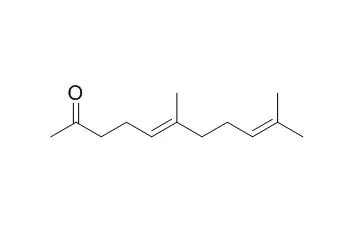Essential oils were obtained by hydrodistillation of the umbels+seeds and stems of Ferula akitschkensis (FAEOu/s and FAEOstm, respectively) and analyzed by gas chromatography and gas chromatography-mass spectrometry.
METHODS AND RESULTS:
Fifty-two compounds were identified in FAEOu/s; the primary components were sabinene, α-pinene, β-pinene, terpinen-4-ol, eremophilene, and 2-himachalen-7-ol, whereas the primary components of FAEOstm were myristicin and Geranylacetone. FAEOu/s, β-pinene, sabinene, γ-terpinene, Geranylacetone, isobornyl acetate, and (E)-2-nonenal stimulated [Ca(2+)]i mobilization in human neutrophils, with the most potent being Geranylacetone (EC50 = 7.6 ± 1.9 μM) and isobornyl acetate 6.4 ± 1.7 (EC50 = 7.6 ± 1.9 μM). In addition, treatment of neutrophils with β-pinene, sabinene, γ-terpinene, Geranylacetone, and isobornyl acetate desensitized the cells to N-formyl-Met-Leu-Phe (fMLF)- and interleukin-8 (IL-8)-induced [Ca(2+)]i flux and inhibited fMLF-induced chemotaxis. The effects of β-pinene, sabinene, γ-terpinene, Geranylacetone, and isobornyl acetate on neutrophil [Ca(2+)]i flux were inhibited by transient receptor potential (TRP) channel blockers. Furthermore, the most potent compound, Geranylacetone, activated Ca(2+) influx in TRPV1-transfected HEK293 cells. In contrast, myristicin inhibited neutrophil [Ca(2+)]i flux stimulated by fMLF and IL-8 and inhibited capsaicin-induced Ca(2+) influx in TRPV1-transfected HEK293 cells.
CONCLUSIONS:
These findings, as well as pharmacophore modeling of TRP agonists, suggest that Geranylacetone is a TRPV1 agonist, whereas myristicin is a TRPV1 antagonist. Thus, at least part of the medicinal properties of Ferula essential oils may be due to modulatory effects on TRP channels. |






 Cell. 2018 Jan 11;172(1-2):249-261.e12. doi: 10.1016/j.cell.2017.12.019.IF=36.216(2019)
Cell. 2018 Jan 11;172(1-2):249-261.e12. doi: 10.1016/j.cell.2017.12.019.IF=36.216(2019) Cell Metab. 2020 Mar 3;31(3):534-548.e5. doi: 10.1016/j.cmet.2020.01.002.IF=22.415(2019)
Cell Metab. 2020 Mar 3;31(3):534-548.e5. doi: 10.1016/j.cmet.2020.01.002.IF=22.415(2019) Mol Cell. 2017 Nov 16;68(4):673-685.e6. doi: 10.1016/j.molcel.2017.10.022.IF=14.548(2019)
Mol Cell. 2017 Nov 16;68(4):673-685.e6. doi: 10.1016/j.molcel.2017.10.022.IF=14.548(2019)